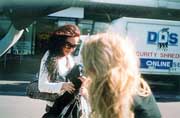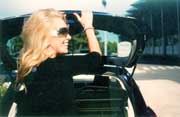|
living:
our people
 Making more than music Making more than music
Laural Barrett, Miss New Zealand 2007, is in Mexico
City contending the Miss Universe
crown. Jack Yan
speaks with her and begins understanding what makes Laural tick and
sets her apart
photographed by Camille
Sanson
make-up and styling by Michiko Hughes
make-up from Napoleon Perdis
Cosmetics
hair by Jock Robson/Dharma
Expanded
from issue 24 of Lucire
MISS NEW ZEALAND—or more accurately, to give its full title, Miss Universe New Zealand—was
not controversial, at least from the judges’ room. It was probably the most clear-cut process one could imagine as Hilary Timmins, Megan Alatini, May Davis, Yvonne Brownlie and I got together and judged the ladies on criteria such as deportment and fluency.
After Christchurch’s Laural Barrett was crowned
on the night of March 31, the back-stabbing began. Rumours appearing
on one website indicated conspiracies and how Barrett,
20, was the anointed winner. The judges, it was alleged, did not
do a thing but confirm the rankings of Val Lott, the pageant director.
It was, of course, all bollocks, but it showed
how catty pageantry can get in the age of the blogosphere.
Then, the Fairfax Press decided to publish what
I regarded as a biased story against Barrett, its tall-poppy motives
clear to all involved.
Above all this was Laural Barrett herself, maintaining
a ladylike dignity and commenting in the most correct
terms—something you’d expect a beauty queen to do. In fact, it’s
something you’d expect Miss Universe to do. Her press interviews
were poised, and you get the feeling she has seen all of this before.
It’s not too far from the truth. Barrett has lived
a good deal of her life in the public eye, but I was surprised to
learn just how much her life—and that of her twin sister Sharaine—had
been leading up to her win.
I type these words as Barrett competes in Mexico City;
they will make it into print a few weeks after her return. Barrett
has emailed a few times with updates and how she is enjoying her
time at the international pageant, joined by Sharaine (who was runner-up
in Miss New Zealand in 2006) and Lott.
Prior to her involvement in the Miss Universe
New Zealand pageant, the Barrett twins had become caregivers to Genesis White, a young mother who had been brain-damaged in a car accident some years ago. There was no fake PR set-up here: as
Barrett tells the story, their involvement with White is one of a sisterly connection with a young woman their own age.
Barrett humorously describes White as ‘very naughty,’ and their visits include ‘turning the music on loud to make it fun for her.’
However, the twins are better known not for social
responsibility—the must-have domain of all beauty queens, it
seems—but their appearances on the Christchurch and Auckland
musical scenes as singers.
After being crowned Miss New Zealand, the sisters
even appeared on TV One’s Good
Morning to perform—rehearsing in the author’s car since they
had not seen each other for over a week.
‘We’ve been singing since we were five. Mum dragged
us into it,’ recalls Barrett. ‘From 12, we went into a band, writing
music. When we were 15, we signed a deal with a manager in Auckland.’
They have appeared on an Australian compilation
CD, Dance Now 2003, and had
briefly moved to Sydney where they met an American music executive
with whom they entered into a development deal. From there,
the sisters lived in Los Angeles for a while, Sharaine returning
first while Laural stayed on for a few extra months. ‘I learned
a lot about the industry,’ she said.
In addition to vocal training—the performance
I heard was arguably strong—Barrett has been taking acting classes,
aware that in the 2000s, gaining a profile as an entertainer necessitates
being multi-talented. Despite being Miss New Zealand, singing remains
both sisters’ first love.
‘Singing is my comfort zone,’ the elder Barrett states.
She describes her mother—a South Carolinian—as
‘very independent and very successful. She has done stuff by
herself. I don’t think I need to rely on anyone.’
Coupled with that independent drive is a belief
that things happen at the right time for the right reasons. The
sisters’ development deal with the Californian company only
came about at Sydney Airport because their flights were changed
and they met the executive by chance.
While the Barrett twins might seem to have been two
girls who left after high school to hit the entertainment circuit,
they have dabbled in property, having found the capital to invest
in their first house and sold it after renovations.
From this point, it became apparent that any
background story on Laural Barrett must be, in part,
|


Above: Laural and her sister Sharaine,
with the Peugeot 207 HDI at Avalon Studios (photographed by
the author).
|
shared with that of her twin sister. While very different in nature—I spent some
time at Wellington Airport with Sharaine as we waited for her
sister’s late plane—the two identical twins have shared many
events in their lives. There is a big sister–little sister relationship
(Laural is the elder; there is the eldest sister, Krystal, who is
23), and despite driving the same brand of car, they admit to one
being tidier than the other.
But there is no Corsican syndrome—a question Barrett
says she confronts regularly.
‘When I was in America, I was there for four months
by myself. I would wake up [feeling] miserable. Then I would get
a phone call and it was Sharaine, upset, because she missed me.’
She says they do finish sentences for each other, but when they
are together, the psychic connection doesn’t noticeably come into
play.
All this travel—with stints living in Sydney and Los
Angeles—has made Barrett a cosmopolitan young woman. ‘A lot of people think
I’m a lot older than 20,’ she says. This certainly helped her chances
in Miss New Zealand, and the confidence is bound to help at Miss
Universe.
The most obvious difference between the sisters is
that Laural dyed her hair blonde. ‘I dyed it back two years ago,
but it just wasn’t the same. People look at blondes differently.
They take brunettes more seriously.’
However, despite being in the public eye, the world
of beauty pageants was still ‘a shock’ to Barrett.
She had only entered one pageant before at 16 in Red
China, a minor one called the New Silk Road Model Look 2003. There,
she had three weeks to herself, but it did not fully prepare her for Miss
New Zealand.
‘I was so nervous,’ she says. ‘It was good. It boosted
my confidence. I really worked hard: I slimmed down a lot, and feel
way better about myself.’
Ten minutes before the show on March 31, she says her
nerves heightened, but ‘halfway [through], after the swimwear, I
was relaxed and happy.’
She does say that her favourite movie is Selena,
the bio-pic about singer Selena Quintanilla-Perez starring Jennifer
Lopez, and not Titanic, the answer she gave to a surprise
question from Timmins toward the end of the evening.
When Barrett’s name was announced, her reaction
was one of shock and surprise—exactly what one would expect
to see at a beauty pageant.
At Miss Universe, Barrett has appeared in many
of the webcasts and publicity photographs, comfortable before
the international photo and video cameras.
I had advised her to not be nervous, passing
on some information given to me by Miss Universe 1983 Lorraine
Downes in late March.
Downes told me that she won because she remembered
that she should not be intimidated. Miss Venezuela, she
recalled, would go in to Miss Universe with an entourage of 15,
each member wearing a jacket with the country’s name emblazoned
on the back. ‘I had to tell myself that only my performance on the
night mattered.’
Another Miss New Zealand—specifically Miss World
New Zealand 2003–4 and MTV host
Amber Peebles—says
that while she had not met Barrett, she believes she has the right
look and manner to help New Zealand go far.
Sylvia Laurenson, who came runner-up to Barrett, speaks
highly of her rival, saying that they have become firm friends.
In Laurenson’s view, the win could not have gone to a more deserving
contestant. The two have remained in regular contact.
It appears that the Barrett–Laurenson friendship
is genuine, especially as Barrett explains that others have not
always taken to her and her sister.
‘Being twins, we do not have a lot of girl friends,
because they can be nasty and bitchy. We know who our real friends
are. We stay away from the negativity,’ she says.
I submit that it could be envy, during a drive
with the sisters on another day for a coffee. Barrett clarifies
that it is not to do with looks. I began understanding what
she meant, based on my career, and advised her that some people
are born to be visionaries, who are set to do things differently
from all their peers. Without them, the world never advances. The
comment seemed to have struck a chord: perhaps there is a greater
scheme at work. Whatever the case, Barrett seems to have the sort
of star quality to carry through her title as Miss New Zealand,
understanding that to fuel her musical career, she needs to conquer
as many media as possible.
Barrett finishes the interview reiterating her dharma:
‘Music is what we want to do.’
Somehow, I think she may wind up creating far
more than that. •
See more of Camille Sanson’s images full size in issue 24 of Lucire along with an update on Laural’s
progress. Pre-order
this issue. Add
to Del.icio.us | Digg
it

|

